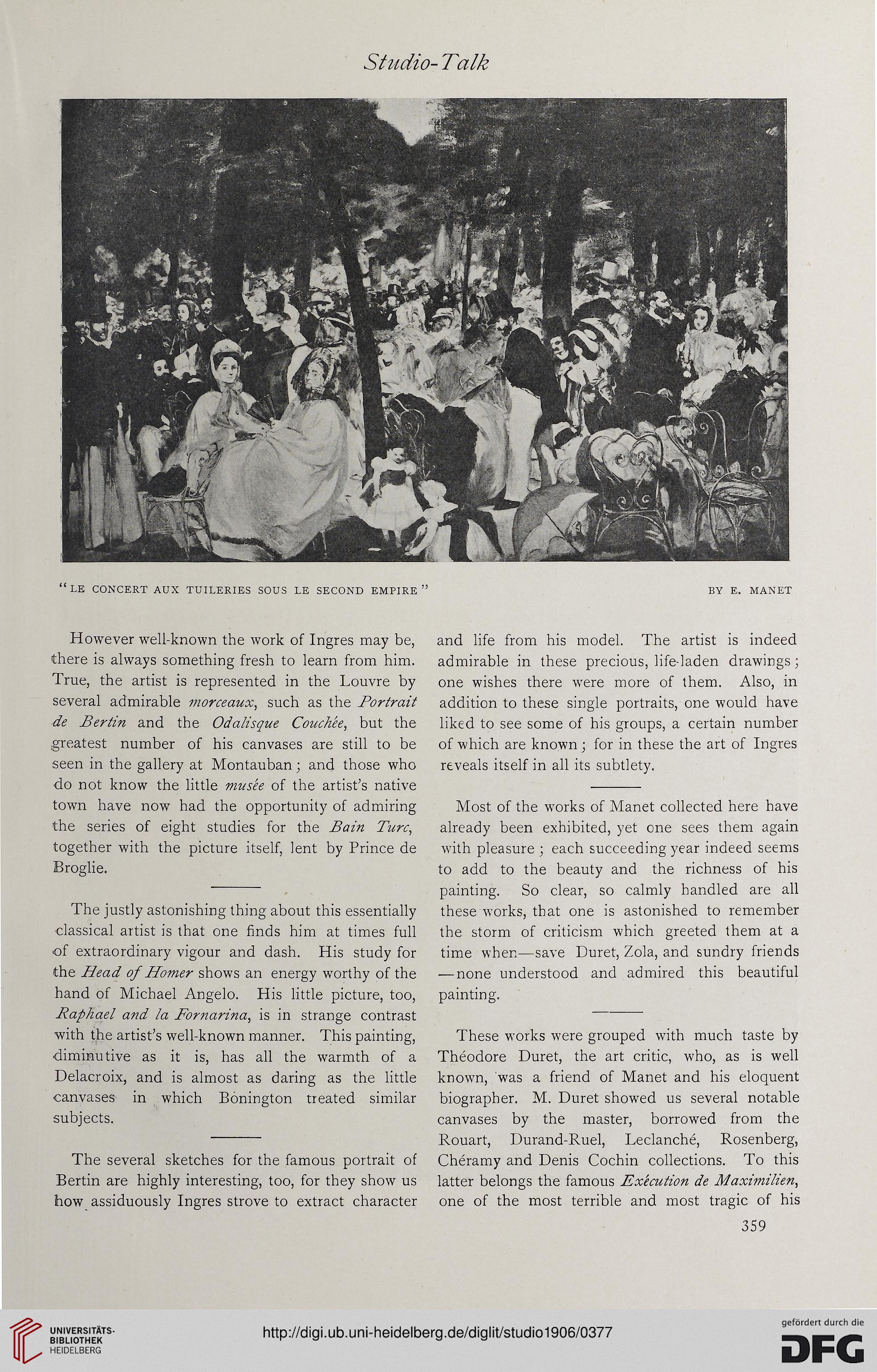Studio- Talk
“ LE CONCERT AUX TUILERIES SOUS LE SECOND EMPIRE”
However well-known the work of Ingres may be,
there is always something fresh to learn from him.
True, the artist is represented in the Louvre by
several admirable morceaux, such as the Portrait
de Bertin and the Odalisque Couchee, but the
greatest number of his canvases are still to be
seen in the gallery at Montauban; and those who
do not know the little mus'ee of the artist’s native
town have now had the opportunity of admiring
the series of eight studies for the Bain Turc,
together with the picture itself, lent by Prince de
Broglie.
The justly astonishing thing about this essentially
■classical artist is that one finds him at times full
of extraordinary vigour and dash. His study for
the Head of Homer shows an energy worthy of the
hand of Michael Angelo. His little picture, too,
Raphael and la Fornarina, is in strange contrast
with the artist’s well-known manner. This painting,
diminutive as it is, has all the warmth of a
Delacroix, and is almost as daring as the little
canvases in which Bonington treated similar
subjects.
The several sketches for the famous portrait of
Bertin are highly interesting, too, for they show us
how assiduously Ingres strove to extract character
BY E. MANET
and life from his model. The artist is indeed
admirable in these precious, life-laden drawings;
one wishes there were more of them. Also, in
addition to these single portraits, one would have
liked to see some of his groups, a certain number
of which are known ; for in these the art of Ingres
reveals itself in all its subtlety.
Most of the works of Manet collected here have
already been exhibited, yet one sees them again
with pleasure ; each succeeding year indeed seems
to add to the beauty and the richness of his
painting. So clear, so calmly handled are all
these works, that one is astonished to remember
the storm of criticism which greeted them at a
time when—save Duret, Zola, and sundry friends
— none understood and admired this beautiful
painting.
These works were grouped with much taste by
Theodore Duret, the art critic, who, as is well
known, was a friend of Manet and his eloquent
biographer. M. Duret showed us several notable
canvases by the master, borrowed from the
Rouart, Durand-Ruel, Leclanche, Rosenberg,
Cheramy and Denis Cochin collections. To this
latter belongs the famous Execution de Maximilien,
one of the most terrible and most tragic of his
359
“ LE CONCERT AUX TUILERIES SOUS LE SECOND EMPIRE”
However well-known the work of Ingres may be,
there is always something fresh to learn from him.
True, the artist is represented in the Louvre by
several admirable morceaux, such as the Portrait
de Bertin and the Odalisque Couchee, but the
greatest number of his canvases are still to be
seen in the gallery at Montauban; and those who
do not know the little mus'ee of the artist’s native
town have now had the opportunity of admiring
the series of eight studies for the Bain Turc,
together with the picture itself, lent by Prince de
Broglie.
The justly astonishing thing about this essentially
■classical artist is that one finds him at times full
of extraordinary vigour and dash. His study for
the Head of Homer shows an energy worthy of the
hand of Michael Angelo. His little picture, too,
Raphael and la Fornarina, is in strange contrast
with the artist’s well-known manner. This painting,
diminutive as it is, has all the warmth of a
Delacroix, and is almost as daring as the little
canvases in which Bonington treated similar
subjects.
The several sketches for the famous portrait of
Bertin are highly interesting, too, for they show us
how assiduously Ingres strove to extract character
BY E. MANET
and life from his model. The artist is indeed
admirable in these precious, life-laden drawings;
one wishes there were more of them. Also, in
addition to these single portraits, one would have
liked to see some of his groups, a certain number
of which are known ; for in these the art of Ingres
reveals itself in all its subtlety.
Most of the works of Manet collected here have
already been exhibited, yet one sees them again
with pleasure ; each succeeding year indeed seems
to add to the beauty and the richness of his
painting. So clear, so calmly handled are all
these works, that one is astonished to remember
the storm of criticism which greeted them at a
time when—save Duret, Zola, and sundry friends
— none understood and admired this beautiful
painting.
These works were grouped with much taste by
Theodore Duret, the art critic, who, as is well
known, was a friend of Manet and his eloquent
biographer. M. Duret showed us several notable
canvases by the master, borrowed from the
Rouart, Durand-Ruel, Leclanche, Rosenberg,
Cheramy and Denis Cochin collections. To this
latter belongs the famous Execution de Maximilien,
one of the most terrible and most tragic of his
359





